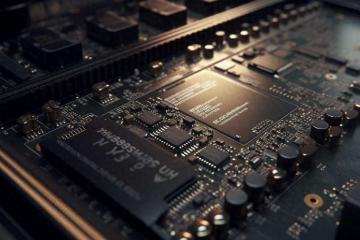AI Chip Demand Fuels Semiconductor Stock Rally
Advertisements
On January 17, the semiconductor sector emerged as a beacon of investment, showcasing a significant upswing in stock prices among related companiesNotably, stocks such as Sangbang Co., Ltd(300661.SZ) and Qingyi Optoelectronics (688138.SH) surged by 20%. Similarly, Naxinwei (688052.SH) saw an impressive increase of over 15%, while Lexin Technologies (688018.SH) climbed by more than 11%. Other firms like Ruixin Microelectronics (603893.SH) and Kangqiang Electronics (002119.SZ) both jumped by approximately 10%. Such collective growth within the market heightens the sector's attractiveness to investors.
This surge corresponds with significant news breaking in the tech worldRecently, the government unveiled a new regulatory framework regarding the export of artificial intelligence (AI) chipsUnder this initiative, the United States has categorized global nations and regions into three distinct classifications, each subject to varying levels of restrictions
Advertisements
This regulatory move is crucial for the burgeoning field of AI, suggesting that the global landscape of chip technology is undergoing a transformation driven by both policy and market dynamics.
Market analysts believe that this regulatory change was anticipated, which is reflected in the enthusiastic response of the semiconductor stocksIn the short term, the new U.Smeasures could potentially impact the domestic AI computational capacity and the advancement of large AI modelsHowever, in the long run, these restrictions may inadvertently accelerate the domestic production efforts within the AI chip industryAs a result, investors are interpreting these developments as positive news, leading to a pronounced increase in stock prices across the semiconductor landscape.
Furthermore, the resurgence within the semiconductor market is also being linked to promising financial performances reported by key industry players
Advertisements
For instance, Northern Hua Chuang (002371.SZ), Zhongwei Company (688012.SH), and Shengmei Shanghai (688082.SH) — all prominent semiconductor equipment manufacturers — shared optimistic earnings forecasts for 2024.
Northern Hua Chuang predicts revenue between 27.6 billion and 31.78 billion yuan, representing a year-on-year growth of 25% to 43.93%. The company expects its net profits attributable to shareholders to reach between 5.17 billion and 5.95 billion yuan, marking an increase of 32.6% to 52.6% compared to the previous yearThis anticipated growth is attributed to the company's expanding operations, heightened efficiencies, and reduced cost-to-revenue ratio, showcasing an optimistic outlook for profitability heading into 2024.
On the other hand, Zhongwei Company forecasts its revenue to hit 9.065 billion yuan, reflecting a robust year-on-year growth of 44.73%. However, it anticipates a 16.01% decrease in net profits attributable to shareholders, primarily due to increased research and development investments and a lack of extraordinary gains from equity disposals — a contrast to the significant profits yielded the previous year from selling stakes in Tuojing Technology.
Despite this potential dip in net profit, Zhongwei expects its non-recurring net profit to range between 1.28 billion and 1.43 billion yuan, suggesting solid overall performance for the year.
Shengmei Shanghai has indicated growth as well, with projected revenue ranging between 5.6 billion and 5.88 billion yuan for the previous fiscal year, signifying an impressive rise between 44.02% and 51.22%. Looking forward, the company expects its full-year revenue for 2025 to sit between 6.5 billion and 7.1 billion yuan, demonstrating continued upward momentum.
The positive results are not only confined to semiconductor equipment, as the AI computational chip sector is also reporting favorable outcomes
Advertisements
Haiguang Information recently released performance forecasts projecting revenues between 8.72 billion and 9.53 billion yuan, indicating a significant increase of up to 58.52% year-on-yearThe net profit attributed to shareholders is also expected to rise to between 1.81 billion and 2.01 billion yuan, reflecting an impressive increase in earnings.
Haiguang also attributed its growth to expanding market share within their CPU product line, catering to a wide range of applications, including data centers and advanced computing needsIn the context of generative AI, their latest DCU (Data Center Unit) products demonstrate rapid developmental progress, further propelling the company's performance and market relevanceSome industry experts even regard these DCUs as potential contenders to replace Nvidia's offerings in the market.
The robust earnings reports from these semiconductor firms underscore a promising outlook within the semiconductor market and highlight the accelerated process of domestic chip production in response to technological advancements and market demand.
Looking forward, Ping An Securities emphasizes that the support from national policies and financial incentives will provide Chinese companies with greater resources and opportunities for development, enhancing their capacity for autonomous innovation
- Interest Rates and the Dollar: The Main Drivers of U.S. Stocks
- Dongfeng Honda Electrifies Lineup, Courts Youth Market
- Leading Solar Companies Facing Significant Losses
- India's Controversial Quest for Foreign Investment
- Seizing the Low-altitude Economy Opportunity
The government is likely to introduce further tax incentives and R&D subsidies aimed at bolstering the semiconductor industry, encouraging increased investment, and attracting top talent into the field.
In the grand scheme of things, the demand for domestically manufactured core technologies — such as semiconductors — is expected to rise, especially amidst the pressures of external technological restrictions and internal industrial upgradesThe willingness and motivation of domestic enterprises to elevate their self-sufficiency is strong, which will open up more market opportunities for Chinese semiconductor manufacturers, thereby enabling significant breakthroughs in technology and production scale.
This transformative period suggests a potential shift from dependency on foreign imports to a more self-sustained ecosystemAs China positions itself to take a more pivotal role within the global semiconductor marketplace, it aims to be a formidable player in terms of technology innovation and product quality, gradually reshaping the dynamics of global supply chains.

Leave A Reply